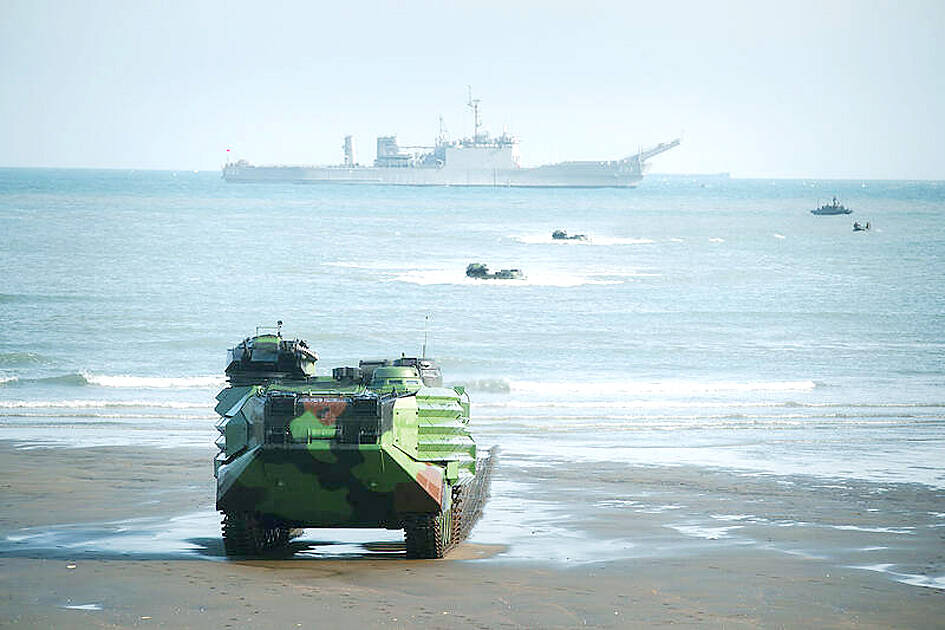The Institute for National Defense and Security Research (INDSR) on Saturday said that the best tactic to counter potential Chinese amphibious warfare using barges would be to cut off their sea-supply lines.
China has in recent years been manufacturing military-standard barges that are widely believed to be used in an amphibious attack to break through Taiwan proper’s line of defense at “red beaches”— beaches that are most suitable for landing operations.
Satellite imagery from foreign news media shows the latest development of China’s amphibious assault vessel at a shipyard in Guangzhou, which is a roll-off ship connected to a barge with enhanced pillars on it.

Photo: CNA
There is also a built-in road bridge that can be extended up to about 130m, the satellite imagery shows.
The Web site Naval News on Jan. 10 published an article saying that “the barge would act as a pier to allow the unloading of trucks and tanks from cargo ships.”
According to the institute’s previous evaluation, the transport capacity of such modified barges would be restricted by the complexity of amphibious operations under tough circumstances.
Cutting off sea-supply lines would be the optimal asymmetric warfare tactic, as the enemy’s first batch of landing troops would soon lose their combat capability, said the INDSR, which is affiliated with the Ministry of National Defense.
An analysis report from the Naval War College’s China Maritime Studies Institute said that Beijing has been providing technical guidelines to domestic shipyards since about a decade ago, with the aim of upgrading a large number of civilian ships to military standards.
Ray Powell, leader of Project Myoushu (South China Sea) at Stanford University, said that civilian roll-off ships are not ideal for amphibious operations, but they could still be used to transport troops at a large scale once Taiwan’s coastal defense is paralyzed.
The INDSR in a report published in 2023 said that the Chinese People’s Liberation Army (PLA) would need to construct a curved, three-dimensional landing field that consists of the red beach, seaports and airports, if Beijing decides to initiate an amphibious attack.
However, the circumstances for the PLA to cross the Taiwan Strait and engage in amphibious landing remain difficult, and their military vessels and civilian ships are not capable of transporting enough troops and supplies, the report said.
Therefore, cutting off the PLA’s sea-supply lines would be an effective tactic, it said, adding Taiwan should nevertheless be aware that the PLA has made progress in adapting civilian ships to amphibious warfare.

Chinese Nationalist Party (KMT) Chairman Eric Chu (朱立倫), spokeswoman Yang Chih-yu (楊智伃) and Legislator Hsieh Lung-chieh (謝龍介) would be summoned by police for questioning for leading an illegal assembly on Thursday evening last week, Minister of the Interior Liu Shyh-fang (劉世芳) said today. The three KMT officials led an assembly outside the Taipei City Prosecutors’ Office, a restricted area where public assembly is not allowed, protesting the questioning of several KMT staff and searches of KMT headquarters and offices in a recall petition forgery case. Chu, Yang and Hsieh are all suspected of contravening the Assembly and Parade Act (集會遊行法) by holding

PRAISE: Japanese visitor Takashi Kubota said the Taiwanese temple architecture images showcased in the AI Art Gallery were the most impressive displays he saw Taiwan does not have an official pavilion at the World Expo in Osaka, Japan, because of its diplomatic predicament, but the government-backed Tech World pavilion is drawing interest with its unique recreations of works by Taiwanese artists. The pavilion features an artificial intelligence (AI)-based art gallery showcasing works of famous Taiwanese artists from the Japanese colonial period using innovative technologies. Among its main simulated displays are Eastern gouache paintings by Chen Chin (陳進), Lin Yu-shan (林玉山) and Kuo Hsueh-hu (郭雪湖), who were the three young Taiwanese painters selected for the East Asian Painting exhibition in 1927. Gouache is a water-based

Taiwan would welcome the return of Honduras as a diplomatic ally if its next president decides to make such a move, Minister of Foreign Affairs Lin Chia-lung (林佳龍) said yesterday. “Of course, we would welcome Honduras if they want to restore diplomatic ties with Taiwan after their elections,” Lin said at a meeting of the legislature’s Foreign Affairs and National Defense Committee, when asked to comment on statements made by two of the three Honduran presidential candidates during the presidential campaign in the Central American country. Taiwan is paying close attention to the region as a whole in the wake of a

OFF-TARGET: More than 30,000 participants were expected to take part in the Games next month, but only 6,550 foreign and 19,400 Taiwanese athletes have registered Taipei city councilors yesterday blasted the organizers of next month’s World Masters Games over sudden timetable and venue changes, which they said have caused thousands of participants to back out of the international sporting event, among other organizational issues. They also cited visa delays and political interference by China as reasons many foreign athletes are requesting refunds for the event, to be held from May 17 to 30. Jointly organized by the Taipei and New Taipei City governments, the games have been rocked by numerous controversies since preparations began in 2020. Taipei City Councilor Lin Yen-feng (林延鳳) said yesterday that new measures by